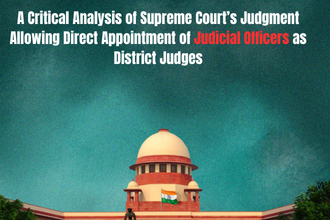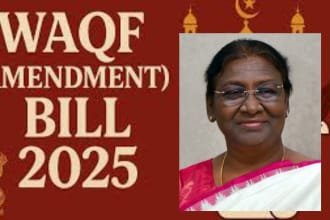Introduction
The Supreme Court’s Constitution Bench judgment in Rejanish KV v K Deepa (2025) has stirred significant debate in legal circles. The verdict, which allows judicial officers with seven years of combined experience in service and advocacy to apply for direct recruitment as District Judges (DJ), marks a major shift in the interpretation of Article 233 of the Indian Constitution.
While the Court intended to expand opportunities for in-service judges, critics argue that the reasoning behind this interpretation lacks constitutional clarity and may blur the distinction between the roles of advocates and judicial officers. On closer examination, the judgment appears to stretch the language of Article 233 beyond its plain meaning, creating legal and structural inconsistencies in the process of judicial appointments.
Background: How District Judge Appointments Worked Before
Before this ruling, the established position under Article 233(2) was that only practising advocates with a minimum of seven years’ experience at the Bar were eligible for direct recruitment as District Judges.
Meanwhile, in-service judicial officers had two separate routes:
- Promotion on a merit-cum-seniority basis (50% quota), and
- Limited Departmental Competitive Examination (LDCE) (25% quota).
The remaining 25% of DJ posts were specifically reserved for direct recruitment from the Bar, intended to infuse new perspectives and experiences from practicing advocates into the judiciary.
However, the new interpretation in Rejanish KV allows serving judicial officers to also compete in this 25% direct recruitment quota — a domain previously exclusive to practising lawyers.
The Constitutional Question: Interpreting Article 233
At the heart of the controversy lies Article 233, which governs appointments of District Judges.
- Article 233(1) deals with promotional appointments made in consultation with the High Court.
- Article 233(2) states that “a person not already in the service of the Union or the State shall only be eligible to be appointed a District Judge if he has been for not less than seven years an advocate or a pleader.”
Historically, judicial precedent — from Satya Narain Singh v. High Court of Allahabad (1985) to Dheeraj Mor v. High Court of Delhi (2020) — upheld a clear distinction:
👉 Article 233(1) applied to in-service officers, and
👉 Article 233(2) applied exclusively to practising advocates.
The Constitution Bench in Rejanish KV, however, reversed this four-decade-old interpretation, holding that the word “advocate” in Article 233(2) does not exclude in-service candidates but rather includes them in addition to advocates.
The Problem: Judicial Overreach and Interpretative Inconsistency
This purposive reinterpretation of Article 233(2) effectively inverts the plain meaning of the text. The provision was explicitly meant to set qualifications for advocates or pleaders seeking appointment as District Judges, not for those already serving in the judiciary.
By extending its scope to include in-service officers, the Court created a logical anomaly:
If the seven-year experience condition applies only to advocates, what experience threshold applies to judicial officers?
To address this inconsistency, the Court judicially inserted a new condition — that serving officers must also have seven years of combined experience (either as advocates or as judges). This move, though meant to “create a level playing field,” amounts to judicial legislation, something beyond the judiciary’s interpretative role.
Comparing Judicial Experience and Litigation Experience: An Unconvincing Analogy
The judgment further claims that *experience gained by judicial officers while serving as judges is greater than that of advocates. This statement lacks empirical support and undermines the *qualitative diversity that practising lawyers bring into the judicial system.
In reality, the two forms of experience are distinct:
- Advocates engage daily with litigants, understand ground-level realities, and develop diverse legal perspectives.
- Judicial officers, on the other hand, gain procedural and institutional experience through adjudication.
Both forms of experience are valuable, but incomparable. The earlier Dheeraj Mor judgment (2020) rightly acknowledged that advocates contribute outside-the-system insights crucial for judicial diversity.
Moreover, the 2025 judgment’s allowance for combined experience (advocacy + judicial service) means that even judicial officers with no prior practice as advocates — those who joined the judiciary before the mandatory three-year practice rule — now qualify for direct recruitment. This contradicts the rationale for requiring advocacy experience in the first place.
The Shetty Commission Report: Misapplied Justification
The Court also relied on the Justice Shetty Commission Report, which had indeed recommended that serving judicial officers be allowed to apply for direct recruitment. However, the Commission had simultaneously suggested that Article 233(2) be amended to enable such inclusion.
By implementing this recommendation judicially instead of legislatively, the Supreme Court bypassed the Constitution’s textual clarity, effectively performing what the Shetty Commission itself acknowledged would require a constitutional amendment.
Purposive Interpretation vs. Plain Meaning: A Misstep
A purposive interpretation is justified only when a plain language interpretation leads to absurd or unjust results. In this case, excluding judicial officers from the 25% direct recruitment quota cannot be termed absurd — since they already occupy 75% of DJ posts through promotion and LDCE.
Hence, the purposive approach adopted here does not correct an absurdity but rather creates a new constitutional confusion. The result is an inversion of the original intent of Article 233(2), blurring the distinct paths that the Constitution had envisaged for advocates and judicial officers.
Structural and Policy Implications
This reinterpretation could disrupt the balance between promoting experienced advocates and providing career progression to judicial officers. It risks:
- Reducing opportunities for practising lawyers, who traditionally infuse new perspectives into the higher judiciary.
- Creating overlaps between promotional and direct recruitment streams, leading to administrative confusion.
- Undermining transparency and meritocracy, as the uniform application of experience criteria becomes difficult to monitor.
The underlying concern of limited promotions for in-service judges is valid. However, the solution lies in systemic reform, not constitutional reinterpretation — reforms like increasing sanctioned strength, ensuring timely promotions, and improving cadre management.
Conclusion
The Supreme Court’s judgment in Rejanish KV v K Deepa is undoubtedly well-intentioned, seeking parity and broader opportunities for judicial officers. Yet, the method it adopts — expanding Article 233(2) beyond its textual meaning — raises constitutional and structural concerns.
By equating judicial experience with advocacy experience, and by introducing judicially crafted eligibility conditions, the Court may have compromised the clarity and coherence of the judicial appointment framework.
The ruling sets a precedent that could blur the traditional divide between advocates at the Bar and officers within the Bench, potentially sidelining meritorious lawyers and unsettling the equilibrium of India’s judicial recruitment system.
On close scrutiny, the judgment, while progressive in intent, appears to fall short of sound constitutional reasoning.
Also Read



